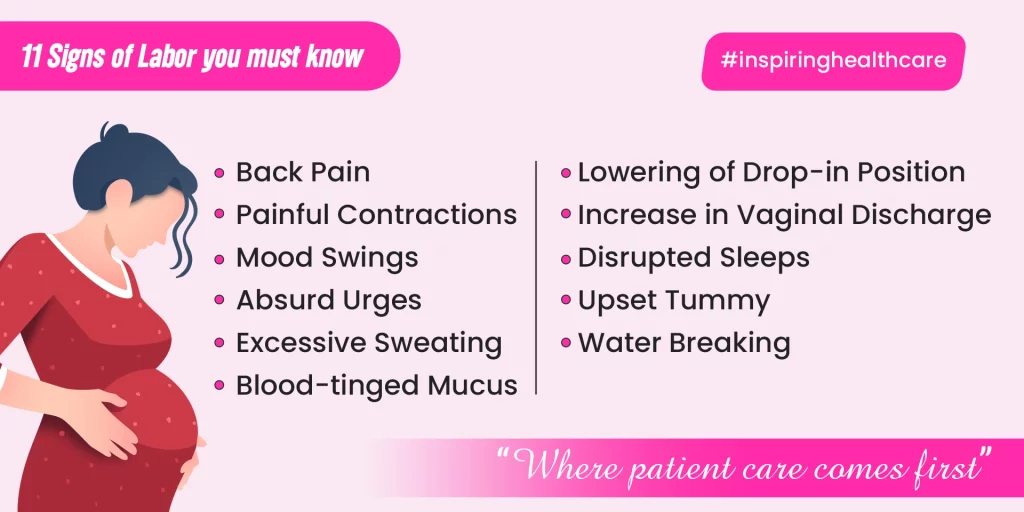Medically Reviewed by: Dr. Swati Singh MBBS, MS (Obs & Gynae), FMAS, DMAS, FIART, CIMP, DCG
Labor is a series of continuous progressive contractions of the uterus that help the cervix dilate and efface (thin out). This lets the fetus move through the birth canal. Labor usually starts two weeks before or after the estimated date of delivery. However, the exact trigger for the onset of the labor is unknown. The World Health Organization defined normal birth as “spontaneous in onset, low-risk at the start of labor & remaining so throughout labor & delivery.
Signs and symptoms of Normal Labor
Normal labor can vary from woman to woman. There are characteristic changes in the body with the impending labor of every woman’s experience is unique and different. The signs and signatures of normal labor can begin in three weeks. The most common signs and symptoms are that labor is approaching.
The baby drops
- Medically known as “lightning,” this is when the baby “drops.”
- The baby’s head descends deeper into the pelvis.
- For some women, this occurs up to 2 weeks before the beginning of labor; other women may not notice this event at all.
An increased urge to urinate
- An increased urge to urinate can be a result of the baby’s head dropping into the pelvis.
- The low position of the baby’s head puts even more pressure on the urinary bladder, so many women approaching labor might feel a frequent need to urinate.
- As the baby drops, breathing can become easier since there is less pressure on the diaphragm from underneath.
Back pain
- Many women note they experience back pain, especially dull pain in the lower back that comes and goes, as labor approaches.
- Back pain may accompany pain abdomen radiating to the inner thighs or may occur on its own.
- Women also notice loosening of the joints, particularly in the pelvic area, as the third trimester progresses, in preparation for delivery.

Stages of Labour
Even though labor is a continuous process, we can see three stages of labor.
1. First Stage
The first stage of labor involves the thinning of the cervix and its dilation to around 10 cm. The first stage is made up of three different phases:
- The latent phase – Generally, this stage is the longest and the least painful part of labor. The cervix thins out and dilates zero to three centimeters. This may occur over weeks, days, or hours and be accompanied by mild contractions. The contractions may be regularly or irregularly spaced, or you might not notice them at all.
- The active phase – The next phase is marked by strong, painful contractions that tend to occur three or four minutes apart, and last from 30 to 60 seconds. The cervix dilates from 3 to 7–8 centimeters.
- The transition phase – During transition, the cervix dilates from 8 to 10 centimeters (that is, fully dilated). These contractions can become more intense, painful, and frequent. It may feel as though the contractions are no longer separate, but running into each other. It is not unusual to feel out of control and even a strong urge to go to the toilet as the baby’s head moves down the birth canal and pushes against the rectum.
Throughout the first stage of labor, careful monitoring and recording of your well-being and that of your baby, and the progress of your labor, is important. This is to ensure that labor is progressing normally and that any problems are recognized early and well communicated.
2. Second Stage
In this stage, the cervix will be fully dilated. It can be treated as the pushing stage. During this stage, the baby, and in particular the baby’s head, has to pass through the maternal pelvis, and normal delivery takes place.
3. Third Stage
After the birth of your baby, your uterus gently contracts to loosen and push out the placenta, although you may not be able to feel these contractions. This may occur 5 to 30 minutes after the birth of your baby.
The muscles of the uterus continue to contract to stop the bleeding. This process is always associated with moderate blood loss – up to 500 ml.
In this stage of labor, one of the potential problems is excessive bleeding (postpartum hemorrhage), which can result in anemia and fatigue. This is why the third stage is carefully supervised.
There are two approaches to managing the third stage:
- Active management – After the birth of your baby, the midwife or doctor gives you (with your consent) an injection of oxytocin, clamps and cuts the umbilical cord, and then carefully pulls on the cord to speed up delivery of the placenta. Active management has been found to reduce excessive blood loss and other serious complications.
- Expectant management – the placenta is allowed to deliver on its own, aided by gravity or nipple stimulation only. In this approach, the umbilical cord stays connected to the baby until the cord stops pulsating.
Monitoring your baby during labour
During labor, your baby’s heart rate will be checked regularly. If you have had a low-risk pregnancy and there are no problems at the onset of labor, your baby’s heart rate will be checked every 15 to 30 minutes using a small hand-held Doppler ultrasound device or Pinard (fetal stethoscope). This equipment can be used regardless of the position you are in.
If you had problems during pregnancy or if problems arise during your labor, your baby’s heart rate may be monitored continuously using a cardiotocograph (CTG).
A CTG involves having two plastic disks (receivers) strapped to your abdomen and held in place by two belts. The receivers are attached to a machine, which may limit your movement. Some hospitals have machines that enable you to move around freely while you are being monitored. This is known as telemetry.
Suggestions for preparing for labor
Some women may find the following activities helpful in preparing for labor:
- Choose your support person – someone you are comfortable with and who will help you rather than distract you during the different stages of labor
- Yoga
- Relaxation exercises
- Hypnotherapy (a state of relaxation)
- Childbirth education – for you and your support person.
Before your baby leaves the hospital, they will have a:
- Detailed physical examination
- Blood tests for various congenital serious diseases. This test is done with a heel prick.
- Hearing test
- Vaccination at birth and guidance about future vaccination & vaccination cards will be provided.
- Regular follow-ups will be explained & advised.
Postnatal Warning Signs
Following your departure from the hospital, it’s important to promptly contact or visit the emergency department if you experience any of the following:
- Heavy vaginal bleeding: While some vaginal bleeding is expected in the weeks after childbirth, inform your doctor or nurse if you notice large blood clots or if the bleeding intensifies.
- Dizziness or faintness
- Fever
- Vomiting
- New abdominal pain
- Severe headache or vision problems
- Feelings of sadness, helplessness, or hopelessness
- Foul-smelling vaginal discharge.
Each delivery and every experience are as unique as the mother and the baby. Understanding the journey aids in anticipation and planning. Congratulations to all expectant mothers!
Looking for top-notch gynecological care in Lucknow? Look no further! At Sanjivini Super Speciality Hospital, Dr. Swati Singh is here to provide expert consultation tailored to your needs. Book your appointment now for comprehensive and compassionate care.

